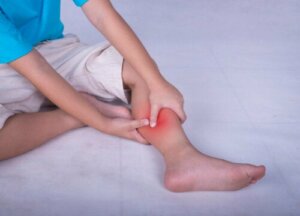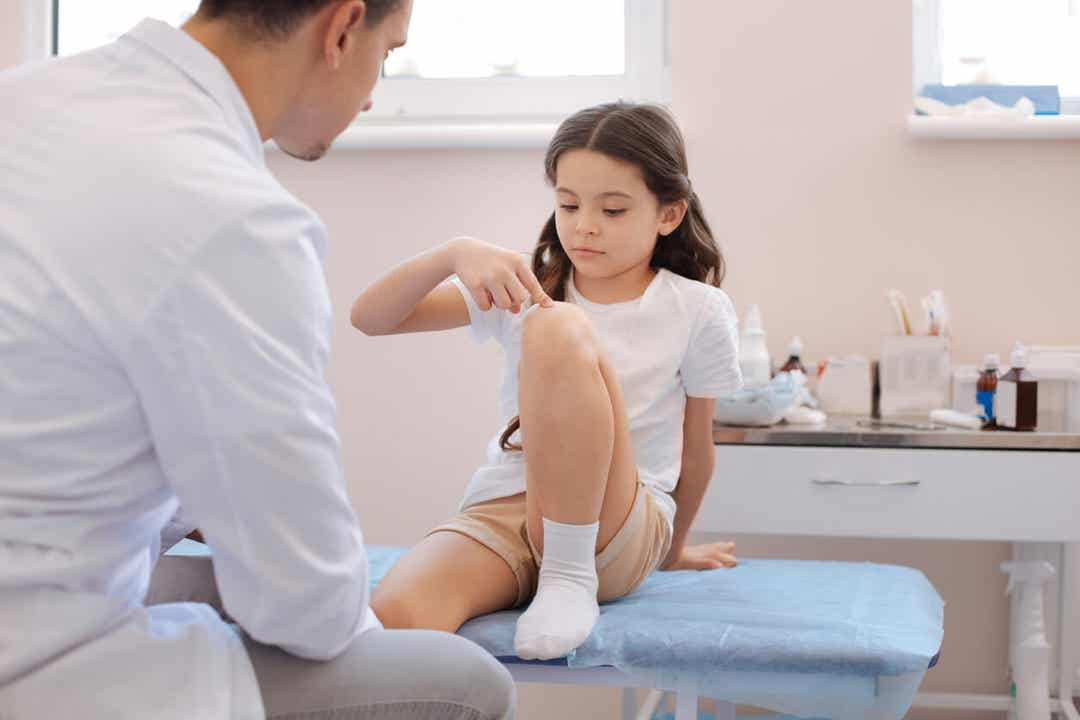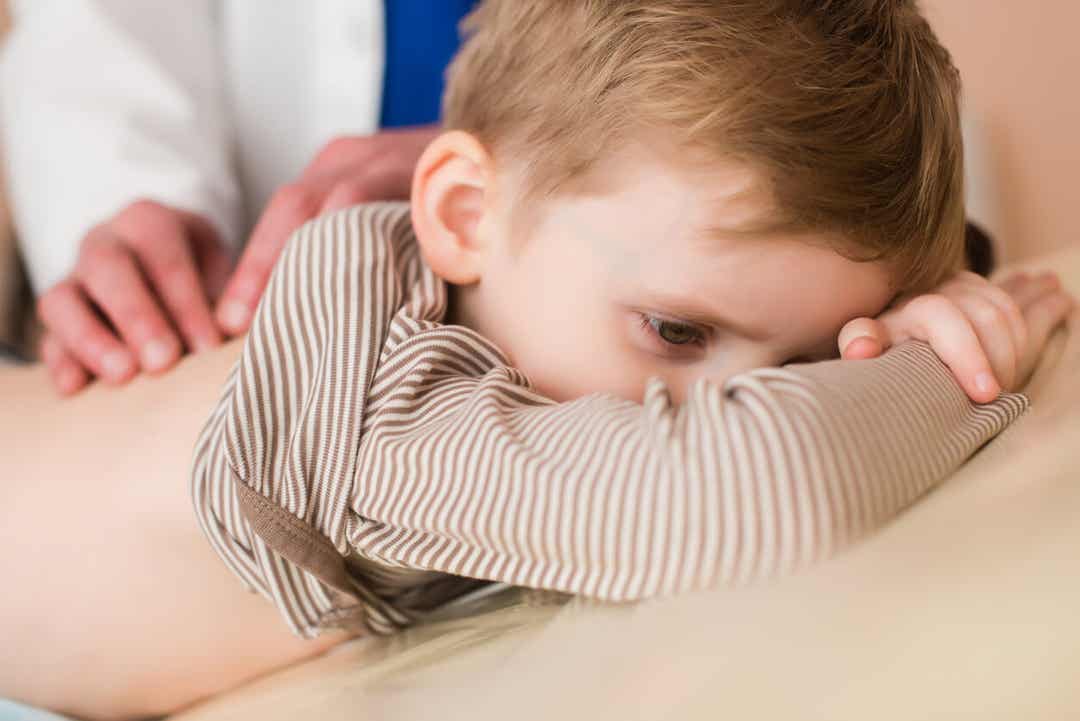The Most Common Muscle Aches and Pains in Children


Written and verified by the physiotherapist Maria Elisa Lisotti Luppi
Muscle aches and pains in children may occur occasionally or permanently. It’s important to evaluate and differentiate the diagnosis of growing pains. Doctors take this into account when applying a specific treatment according to the needs and characteristics of each child.
Myalgia, i.e. muscle pain, can occur during infancy. They are usually continuous pains that obtain relief with manual techniques and, occasionally, with analgesic treatments.
As the child develops, their bone structure grows, as well as their muscles and ligaments. This growth is gradual and progressive. Some authors suspect that a muscular imbalance generates alterations in muscular tensions. Experts believe this to be one of the causes of growing pains.
What are muscle aches?

Pain’s a complex symptom, influenced by physical, emotional, and social factors among many others. Muscle aches are discomfort that can occur in a single muscle or in muscle groups. What’s more, it can be momentary or last for months or even years.
The intensity of muscle pain in children varies from mild to intolerable levels. Moreover, in some cases, it disappears spontaneously and, in others, professional treatment is necessary. In adults, back and neck pain are very common. However, in children, muscle aches are more frequent in the legs.
How to know if your child has muscle pain
Children usually express their muscle aches on their own, In other words, they point directly to the area of discomfort. In some cases, they may also experience some alteration in the way they walk or in their posture. This is because they unconsciously seek to relieve their discomfort.
Another characteristic of muscular pain is that it can occur at any time of the day or throughout the whole day. In addition, muscle aches can be present anywhere in the body, whether in the back, neck, arms, or legs.
The most common aches and pains: Growing pains
Growing pains usually occur in children’s legs as they develop. However, there’s no single theory to explain their cause. Some authors speak of muscle fatigue, others point to it as a symptom that’s secondary to an alteration in posture.
There’s another theory that talks about emotional factors that directly influence muscular pain in children. And there’s yet another one that talks about nocturnal growth, thanks to the increase of growth hormone during the night.
This could explain the cause of the characteristic pain they produce. However, at present, there’s no definitive proof. They usually occur in the evening or at night, and may even awaken children from their sleep. Although, at the same time, kids can go for days without pain. Generally, growing pains occur in lower limbs, and the pain’s more frequent in children between 3 to 13 years of age.
How to differentiate growing pains from muscle pains
Growing pains usually appear for a few minutes. After about half an hour, they disappear and then reappear. However, muscle aches in children are felt permanently and upon palpation. The pain’s persistent and may increase in intensity.
The location of the pain is another factor to consider in order to differentiate it. Growing pains occur more frequently in the legs, bilaterally. Muscular growing pains can affect any part of the body, unilaterally, or in both limbs.
The most appropriate treatments
After a complete physical examination, the doctor will decide on a treatment, considering the individual evaluation and in consensus with the parents and the health care team.

In some cases, the treatment’s complemented with analgesics prescribed by the physician. Physical therapy will be aimed at reducing pain and improving mobility. As well as improving posture and general functionality in the child. It’s important that parents provide emotional support for as long as the symptoms last.
In most cases, growing pains disappear over the years. However, treatment’s carried out to alleviate the symptoms and improve the child’s relaxation. The physical therapist’s treatment includes massage therapy, active exercises for muscle flexibility, balance, posture, and body awareness. In addition, parents should learn techniques for massaging the affected area during the night, at times when the child experiences pain.
Therefore, if your child reports pain in any part of their body during the day on a permanent basis, it’s probably muscle pain. Otherwise, if the pain’s intermittent, appears closer to the night or during sleep, and affects the legs, it’s probably a growing pain.
In any case, in the presence of any pain in the child, consulting a pediatrician to rule out other possible diseases is essential. Physical therapy treatment helps to reduce or even eliminate the symptoms, which undoubtedly affect your child’s daily life.
Muscle aches and pains in children may occur occasionally or permanently. It’s important to evaluate and differentiate the diagnosis of growing pains. Doctors take this into account when applying a specific treatment according to the needs and characteristics of each child.
Myalgia, i.e. muscle pain, can occur during infancy. They are usually continuous pains that obtain relief with manual techniques and, occasionally, with analgesic treatments.
As the child develops, their bone structure grows, as well as their muscles and ligaments. This growth is gradual and progressive. Some authors suspect that a muscular imbalance generates alterations in muscular tensions. Experts believe this to be one of the causes of growing pains.
What are muscle aches?

Pain’s a complex symptom, influenced by physical, emotional, and social factors among many others. Muscle aches are discomfort that can occur in a single muscle or in muscle groups. What’s more, it can be momentary or last for months or even years.
The intensity of muscle pain in children varies from mild to intolerable levels. Moreover, in some cases, it disappears spontaneously and, in others, professional treatment is necessary. In adults, back and neck pain are very common. However, in children, muscle aches are more frequent in the legs.
How to know if your child has muscle pain
Children usually express their muscle aches on their own, In other words, they point directly to the area of discomfort. In some cases, they may also experience some alteration in the way they walk or in their posture. This is because they unconsciously seek to relieve their discomfort.
Another characteristic of muscular pain is that it can occur at any time of the day or throughout the whole day. In addition, muscle aches can be present anywhere in the body, whether in the back, neck, arms, or legs.
The most common aches and pains: Growing pains
Growing pains usually occur in children’s legs as they develop. However, there’s no single theory to explain their cause. Some authors speak of muscle fatigue, others point to it as a symptom that’s secondary to an alteration in posture.
There’s another theory that talks about emotional factors that directly influence muscular pain in children. And there’s yet another one that talks about nocturnal growth, thanks to the increase of growth hormone during the night.
This could explain the cause of the characteristic pain they produce. However, at present, there’s no definitive proof. They usually occur in the evening or at night, and may even awaken children from their sleep. Although, at the same time, kids can go for days without pain. Generally, growing pains occur in lower limbs, and the pain’s more frequent in children between 3 to 13 years of age.
How to differentiate growing pains from muscle pains
Growing pains usually appear for a few minutes. After about half an hour, they disappear and then reappear. However, muscle aches in children are felt permanently and upon palpation. The pain’s persistent and may increase in intensity.
The location of the pain is another factor to consider in order to differentiate it. Growing pains occur more frequently in the legs, bilaterally. Muscular growing pains can affect any part of the body, unilaterally, or in both limbs.
The most appropriate treatments
After a complete physical examination, the doctor will decide on a treatment, considering the individual evaluation and in consensus with the parents and the health care team.

In some cases, the treatment’s complemented with analgesics prescribed by the physician. Physical therapy will be aimed at reducing pain and improving mobility. As well as improving posture and general functionality in the child. It’s important that parents provide emotional support for as long as the symptoms last.
In most cases, growing pains disappear over the years. However, treatment’s carried out to alleviate the symptoms and improve the child’s relaxation. The physical therapist’s treatment includes massage therapy, active exercises for muscle flexibility, balance, posture, and body awareness. In addition, parents should learn techniques for massaging the affected area during the night, at times when the child experiences pain.
Therefore, if your child reports pain in any part of their body during the day on a permanent basis, it’s probably muscle pain. Otherwise, if the pain’s intermittent, appears closer to the night or during sleep, and affects the legs, it’s probably a growing pain.
In any case, in the presence of any pain in the child, consulting a pediatrician to rule out other possible diseases is essential. Physical therapy treatment helps to reduce or even eliminate the symptoms, which undoubtedly affect your child’s daily life.
All cited sources were thoroughly reviewed by our team to ensure their quality, reliability, currency, and validity. The bibliography of this article was considered reliable and of academic or scientific accuracy.
- Giménez Garrote, Anna. “Dolores de crecimiento y su tratamiento. Revisión bibliográfica.” (2017). http://diposit.ub.edu/dspace/handle/2445/114221
- Reyes-Cadena, A. “El niño con dolor de piernas.” Acta pediátrica de México 37.3 (2016): 183-187. http://www.scielo.org.mx/scielo.php?pid=S0186-23912016000300183&script=sci_arttext
- Bustamante, Lorena Ibáñez, Abel Hernández Arévalo, and Adriana Mejía. “Manejo osteopático del dolor de miembros inferiores en niños, asociado al crecimiento.” Revista Colombiana de Medicina Física y Rehabilitación 27.1 (2017): 49-67. https://revistacmfr.org/index.php/rcmfr/article/view/183
- Matos, Rocío Cáceres. “Afrontamiento y consecuencias del dolor crónico en niños, niñas y adolescentes. Revisión bibliográfica.” (2016). https://idus.us.es/handle/11441/99025
- Cruz, Enrique, Andrea Simian, and Andrés Chahin. “DOLOR LUMBAR EN NIÑOS.” Revista Médica Clínica Las Condes 31.5-6 (2020): 404-416. https://www.sciencedirect.com/science/article/pii/S0716864020300766
- Márquez, José María Cañizares, and Carmen Carbonero Celis. Crecimiento y desarrollo del niño. Vol. 3. Wanceulen Editorial, 2017.
- González Montesinos, J. L., Martínez González, J., Mora Vicente, J., Salto Chamorro, G., & Álvarez Fernández, E. (2004). El dolor de espalda y los desequilibrios musculares. https://repositorio.uam.es/bitstream/handle/10486/3694/25623_2.pdf?sequence=1&isAllowed=y
This text is provided for informational purposes only and does not replace consultation with a professional. If in doubt, consult your specialist.








